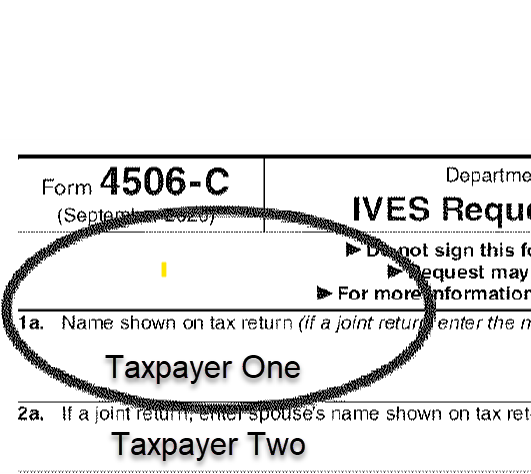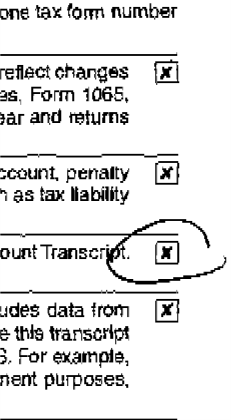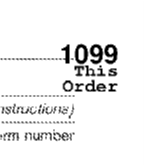Issue Number: Deviation Impact Bulletin 2
Inside This Issue
- Form 4506-C Deviation Impact to Upcoming IVES automation
- FAQ for Form 4506-C Deviation Change Requirements
-
Examples of Form 4506-C Deviations
1. Form 4506-C deviation impact to upcoming IVES automation
This notification was previously emailed out on August 9, 2021
Dear IVES participants,
As you may have heard, IVES is implementing a processing modernization. This will bring much needed automation advances to our current manual process, greatly improving our efficiency in response to the industry’s transcript needs.
The first step in this Modernization effort will be the inclusion of Optical Character Recognition (OCR) software. OCR programming will read the Form 4506-C as the form was intended. In order for the clean version of the form to be accepted by the Optical reader, it should:
• Be clear of any editing marks
• Only identify the transcripts, tax years, and/or taxpayers that need to be processed
• List the data on the assigned lines
It is vital that all participants adhere to this clean version in the completion of Form 4506-C for a successful integration of OCR in the IVES Modernization. Please refer to the Form 4506-C’s general instructions to ensure correct form completion.
The IRS is aware time is needed to update technology and communication within each participant’s organization. The OCR software is expected to go live in October of 2021 and the automation process will work side-by-side with our previous manual processing to start. Submissions received from IVES participants that have not made the adjustment to submitting a clean version of the Form 4506-C requests to integrate with the OCR software by October of 2021, will be routed to the manual processing and will follow that processing timeframe.
Effective January 1, 2022, all participants must have updated their Form 4506-C submissions to match this clean version. This will permit all submissions to be incorporated into the modernization software and phase out the previous manual process. Failure to submit a clean version of the Form 4506-C at this point may result in increased rejections or additional authorized transcript receipts which will be chargeable to the IVES participant.
Thank you,
IRS IVES Team
Back to Top
2. FAQ for Form 4506-C deviation change requirements
Dear IVES participants,
Below are some of the questions and requests for clarification received from IVES Participants. Please utilize this FAQ to ensure your company is accurately understanding the Form 4506-C deviation change requirements.
1. Currently most of the 4506-C forms we receive have all boxes, forms, years filled in and we circle what exactly they are requesting based on the order we receive. Will that need to change?
Yes, this will need to change. Starting in Oct 2021, continuing to submit requests with these deviations will route the request into manual processing as previous. But as of Jan 1, 2022, submitting requests with these deviations will result in either increased rejections or additional authorized transcripts being sent and charged.
2. For wage and income transcript requests (W2, 1099, etc.), would circling the spouse’s name be routed to manual processing and once the clean version is 100% enforced on Jan 1, 2022, will circling be no longer acceptable? If both applicants’ names are on the form, then the IRS will send transcripts for both applicants?
Prior to Jan 1, 2022 this deviation would route the request into manual processing. Effective Jan 1, 2022, the form would be acceptable but the clarification of only one taxpayer would not be accepted. The request would be read as wage and income request for both taxpayers.
3. Starting with the October change, will all our orders/documents still go to the same mailbox? Or will we need to separate out the “clean” documents (new format) from the deviations and send separately?
The upcoming IVES automation will not impact the SOR mailbox locations, your requests will still go to the indicated SOR mailbox as listed on Line 5a.
If a document within the batch contains the clarifying circles in your example, then the entire batch will be moved to manual processing and remain worked together as normal. If you are able to separate out clean versions of the F4506-C into their own batch, we will move the entire batch into the automation processing sooner. This may be of benefit to your organization while adjusting to the process of a clean version of the F4506-C.
4. Since a computer will be reading the request, will the system be able to handle variations on line 5a or is there a structured line 5a that MUST sent?
Currently we are working diligently with our developers to ensure variations on line 5a will not negatively impact our IVES partners. If it is determined that a more structured entry is required, we will share that with all the IVES Participants, while providing the opportunity to adjust to any changes.
5. Will batches sent into the clean form workflow experience a quicker turn-time?
We will closely monitor the manual and automation process to ensure the integrity of the FIFO is maintained. That being said, as more and more participants are able to adhere to the clean form sooner than the required Jan 1, 2022, our processing time will be expected to improve.
6. Should the 4506-C form only be filled out to what specifically is needed as the OCR program will not be able to identify that the circled information is all that we need?
Yes, this is correct. Starting in Oct 2021, continuing to submit requests with these deviations will route the request into manual processing as previous. But as of Jan 1, 2022, submitting requests with these deviations will result in either increased rejections or additional authorized transcripts being sent and charged.
7. Regarding the “editing marks”, what is considered an editing mark?
Currently some participants notate in the margins which taxpayer, product, or year they are requesting. Continuing to deviate in this manner will route the request into manual processing as of Oct 2021 and effective Jan 1, 2022, submitting requests with these deviations will result in either increased rejections or additional authorized transcripts being sent and charged.
8. We edit our SOR mailbox in the top margin of the request, would this be considered “editing marks”?
Yes, as the SOR mailbox has a field assigned to it, this will also be considered a deviation with “editing marks.” Starting in Oct 2021, continuing to submit requests with these deviations will route the request into manual processing as previous. But as of Jan 1, 2022, submitting requests with these deviations will result in either increased rejections or additional authorized transcripts being sent and charged.
9. Our company uses a Unique Identifier and was told that this should be listed in the top right margin of the request. Do we have to stop using these?
No, the Unique Identifier does not have a field on the Form 4506-C assigned to it yet so you will continue to include this number in the top right margin of the request. We are working with our developers to ensure this space is collected. BUT you will want to make sure this is the only information that is listed here. Additional information listed has impacted the software’s ability to capture the Unique Identifier.
Thank you,
IRS IVES Team
Back to Top
3. Examples of Form 4506-C deviations
Dear IVES participants,
Below are some examples of deviations currently seen on the Form 4506-C that starting in Oct 2021, continuing to submit requests with these deviations will route the request into manual processing as previous. But as of Jan 1, 2022, submitting requests with these deviations will result in either increased rejections or additional authorized transcripts being sent and charged.
Please utilize these examples to ensure your company is understanding the Form 4506-C changes being required.
1. Example of listing both Taxpayers and circling or boxing the one Taxpayer that is requesting the transcript.
 
2. Example of listing multiple years and circling the specific years requested.

3. Example of listing multiple products and circling or boxing the one requested.
 
4. Example of listing a Unique Identifier with a SOR Mailbox in the top Margins. The Unique Identifier can stay listed here – the SOR Mailbox is a deviation and will need to move.

5. Example of editing marks.
 
Thank you,
IRS IVES Team
Back to Top
    
Thank you for subscribing to IVES Program e-News and Updates, an IRS e-mail service. For more information on the IVES program please visit IRS.gov.
This message was distributed automatically from the IVES Program e-News and Updates mailing list. Please Do Not Reply To This Message.
|
![]()







